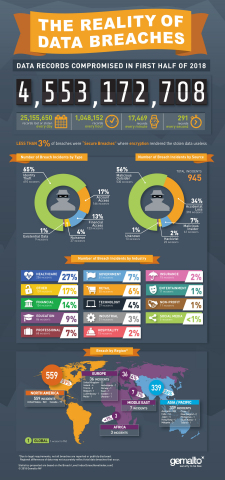AMSTERDAM--(BUSINESS WIRE)--Gemalto, the world leader in digital security, today released the latest findings of the Breach Level Index, a global database of public data breaches, revealing 945 data breaches led to 4.5 billion data records being compromised worldwide in the first half of 2018. Compared to the same period in 2017, the number of lost, stolen or compromised records increased by a staggering 133 percent, though the total number of breaches slightly decreased over the same period, signaling an increase in the severity of each incident.
A total of six social media breaches, including the Cambridge Analytica-Facebook incident, accounted for over 56 percent of total records compromised. Of the 945 data breaches, 189 (20 percent of all breaches) had an unknown or unaccounted number of compromised data records.
The Breach Level Index is a global database that tracks data breaches and measures their severity based on multiple dimensions, including the number of records compromised, the type of data, the source of the breach, how the data was used, and whether or not the data was encrypted. By assigning a severity score to each breach, the Breach Level Index provides a comparative list of breaches, distinguishing data breaches that are not serious versus those that are truly impactful.
According to the Breach Level Index, almost 15 billion data records have been exposed since 2013, when the index began benchmarking publicly disclosed data breaches. During the first six months of 2018, more than 25 million records were compromised or exposed every day, or 291 records every second, including medical, credit card and/or financial data or personally identifiable information. This is particularly concerning, since only one percent of the stolen, lost or compromised data records were protected by encryption to render the information useless, a percent-and-a-half drop compared to the first six months of 2017.
"Obviously, this year social media has been the top industry and threat vector for the compromise of personal data, a trend we can expect to continue with more and more sectors leveraging these platforms to reach key audiences, especially political teams gearing up for major elections," said Jason Hart, vice president and chief technology officer for data protection at Gemalto. "We also expect to see more data breaches reported by European Union countries bound by the new General Data Protection Regulation and in Australia with the new Notifiable Data Breaches law. We should be careful not to misconstrue this as an increase in overall incidents in these areas but rather as a more accurate reflection of what is actually going on."
Primary Sources of Data Breaches
Malicious outsiders caused
the largest percentage of data breaches (56 percent), a slight decrease
of almost seven percent over the second half of 2017 and accounted for
over 80 percent of all stolen, compromised or lost records. Accidental
loss accounted for over 879 million (9 percent) of the records lost this
half, the second most popular cause of data breaches representing over
one third of incidents. The number of records and incidents involved in
malicious insider attacks fell by 50 percent this half compared to the
same time period in 2017.
Leading Types of Data Breaches
Identity theft continues to
be the leading type of data breach, as it has been since Gemalto first
started tracking in 2013. While the number of identity theft breaches
increased by 13 percent over the second half of 2017 to just over 64
percent, the number of records stolen through these incidents increased
by 539 percent, representing over 87 percent of all records stolen.
Financial access incidents show a disturbing trend in the escalation of severity. Though overall incident numbers are on the decline H1 2017 vs. H1 2018 (171 for H1 2017 and 123 for H1 2018), the number of records breached increased H1 2017 vs. H1 2018 (2.7 million and 359million) respectively.
Industries Most Affected by Data Breaches
Most sectors saw
an increase in the number of incidents compared to the previous half –
the exceptions were government, professional services, retail and
technology, though both government and retail saw an increase in the
number of records breached through fewer events.
Healthcare continues to lead in number of incidents (27 percent). The largest such incident, 211 LA County, exposed 3.5 million records through accidental loss.
Social media ranks top for number of records breached (56 percent) due to the high-profile customer data compromises at Facebook and Twitter, involving 2.2 billion and 336 million respectively.
Geographic Distribution of Data Breaches
North America still
makes up the majority of all breaches and the number of compromised
records, 59 and 72 percent respectively. The United States is still by
far and away the most popular target for attacks, representing more than
57 percent of global breaches and accounting for 72 percent of all
records stolen, though overall incidents are down 17 percent over the
prior half.
With the implementation of the Notifiable Data Breaches law, the number of incidents in Australia increased dramatically from 18 to 308 as could be expected.
Europe saw 36 percent fewer incidents but a 28 percent increase in the number of records breached indicating growing severity of attacks. The United Kingdom remains the most breached country in the region. With the General Data Protection Regulation in full effect for the second half of 2018, the number of reported incidents could begin to rise.
Related Resources:
- For a full summary of data breach incidents by industry, source, type and geographic region, download the First Half 2017 Breach Level Index Report
- Download the infographic here
- Visit the BLI website here
About Gemalto
Gemalto (Euronext NL0000400653 GTO) is the global leader in digital security, with 2017 annual revenues of €3 billion and customers in over 180 countries. We bring trust to an increasingly connected world.
From secure software to biometrics and encryption, our technologies and services enable businesses and governments to authenticate identities and protect data so they stay safe and enable services in personal devices, connected objects, the cloud and in between.
Gemalto’s solutions are at the heart of modern life, from payment to enterprise security and the internet of things. We authenticate people, transactions and objects, encrypt data and create value for software – enabling our clients to deliver secure digital services for billions of individuals and things.
Our 15,000 employees operate out of 114 offices, 40 personalization and data centers, and 35 research and software development centers located in 47 countries.
For more information visit www.gemalto.com, or follow @gemalto on Twitter.




